1984 Cadillac Seville: Cameo Ivory Cream Puff
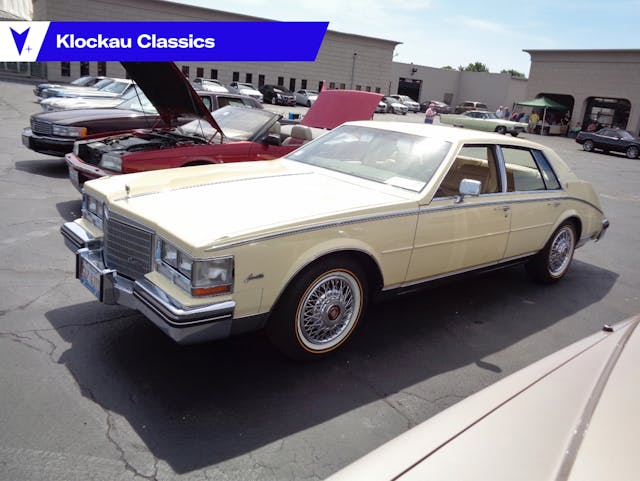
I’ve already extolled rampantly about the original 1976–79 Cadillac Seville. It was a game-changer, for both Cadillac and GM, helped Cadillac expand into new customer bases, and sold well during its four years on the market. But by 1979 it was time for a new design. Yes folks, today we’re going to be discussing the star-crossed, polarizing, “bustle back” 1980–85 Seville! That’s right. Hold onto your hats!
Cadillac almost always had far more models than cross-town rival, Lincoln. The Seville usually was thought to compete with the Lincoln Versailles (despite its family car origins) and later on, the Fox-bodied Continental, which was also conveniently bustle-backed to avoid confusion. As you would expect, this was not a cheap car in 1984. The factory base price was $22,468 (about $65K in today’s money). It weighed in at 3844 pounds, and 39,997 were built for the model year. The Elegante package, which included two-tone paint, 40/40 divided front seat, leather-wrapped steering wheel, and plush seats with an integrated center console, was an extra $3879 ($11,232) over the base price. By 1984, this generation was in its next to last year and had been on the market for five.

While that price was a lot of money that year, it still wasn’t the most expensive Cadillac. The Eldorado convertible was $31,286 ($90,588) and the Fleetwood 75 limo went for $30,454 ($88,179) while the formal limo (a glass divider between the front and rear compartments was the primary difference between the two limos) went for $31,512 ($91,242).

And while I’m delving into my Cadillac facts and figures, the cheapest Cadillac that year was—as you might suspect—the Cimarron, which had a base price of $12,614 ($36,524). But that’s a car to discuss some other time. Don’t worry, I’ll get to it one of these days!
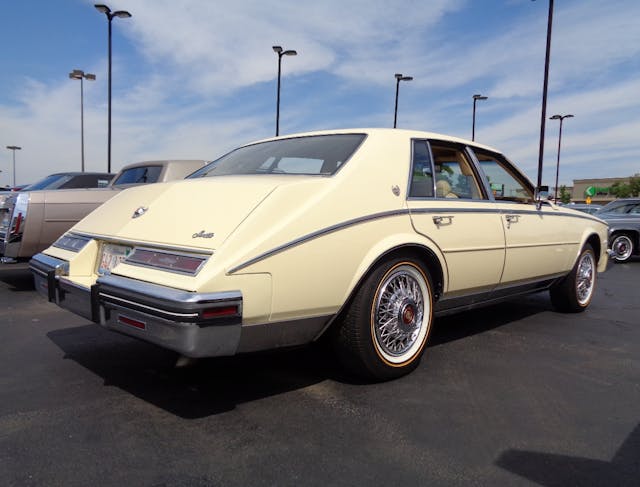
Starting in 1980, the Seville now shared its chassis with the E-body Cadillac Eldorado, Oldsmobile Toronado, and Buick Riviera. The only four-door E body GM car, it had a 114-inch wheelbase and overall length of 204.8 inches. The GM personal-lux cars had been downsized and completely redesigned in 1979. Like the Seville, they would all last through the 1985 model year with only minor changes. There had been some preliminary designs for the new-for-’80 Seville that looked much like a four-door 1979 Eldorado, but outgoing GM VP of Design Bill Mitchell, who adored neoclassic touches and owned several classic cars, insisted the neo-Hooper coachbuilt look be utilized. The result was this car.
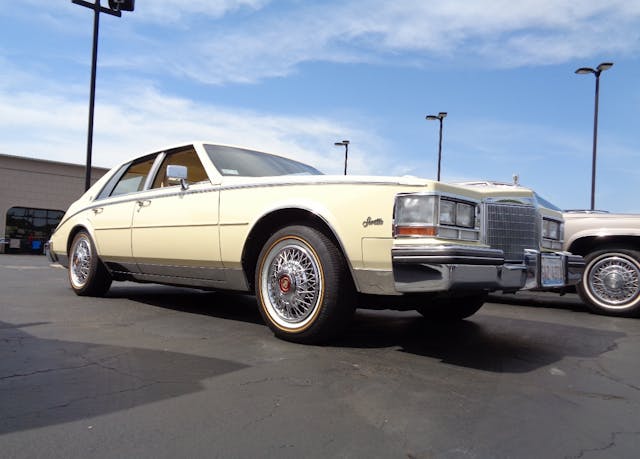
The 368-cubic-inch Cadillac V-8 was standard in 1980–81, but starting in 1982 it was replaced with the smaller (um, leisurely?) HT4100 V-8. The 5.7-liter diesel was standard at first and later on became a no-cost option. As you might suspect, I really like these cars, because—Brougham. That said, I don’t think it was the right direction for the Seville to take. The original 1976 Seville was in a class of its own: a smaller, more maneuverable, more fun to drive Cadillac with styling closer to the European sedans, which were finding so much favor at the time.

Imagine the surprise: 1980 rolls around and the Seville is no longer a light, relatively nimble class-of-its-own luxury car (I know, I know, it wasn’t a sports car, but it was compared to, say, a Fleetwood Talisman). Instead, it went full-on baroque with rampant Broughamage. Sure, I like them, but it’s a stretch to claim they had youthful appeal.

The preferred upwardly-mobile, upper-middle-class cars in 1984 were rides like the BMW 3-Series, Audi 4000, Mercedes 190E, Saab 900, and Volvo GL. Maybe a Toyota Cressida or Accord LX, or Cutlass Supreme, Thunderbird, or Cougar. I should know; my parents drove Volvo 240s during this time period, one uncle had a white Subaru wagon, and my older uncle had a Suburban. Sure, the Seville was more expensive than all of those, but while the 280E owner might have lusted for a 450SEL, he probably wasn’t drooling over Sevilles and Continentals. The only people I knew back then who had a Cadillac were the Hesemans, who went to our church and drove a black 1983 or ’84 Sedan de Ville. They were in their late 50s at the time.

You know the old chestnut about selling a young man’s car to an old man, but not an old man’s car to a young one. I may have bought two Town Cars in my 30s, but I’m a loose cannon! So this generation of Seville sold 39,344 in its first year, dipped down to 19,998 in 1982, rose to 30,430 in 1983, and then hovered around 40,000 in 1984–85 before being put out to pasture for an even more downsized 1986 Seville. Which did not have a bustle back.
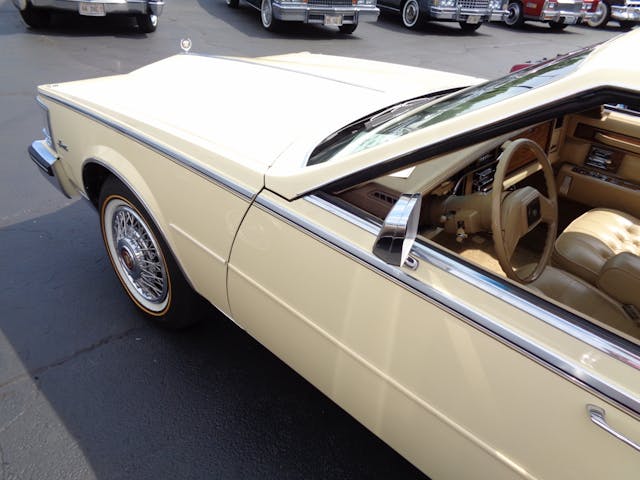
Instead of being something your wealthy younger aunt and uncle might take to the tennis club (or so Cadillac sincerely hoped, from period advertising), it looked more like something Smithers would drive Mr. Burns to the nuclear plant in.

As one of Cadillac’s top-of-the-line cars, there were only a few optional extras and some big-ticket extras, including the power-glass Astroroof ($1225), Delco-GM/Bose sound system ($895), and a digital instrument cluster ($238).
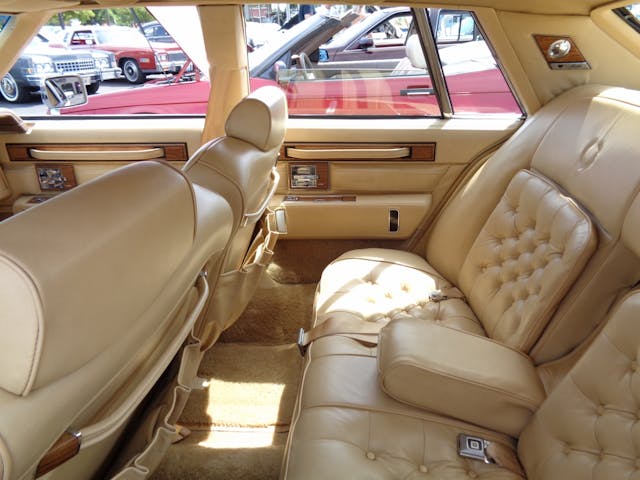
The floating-pillow seating shown on today’s gorgeous example, an ’84 in Cameo Ivory, was new for 1984 and replaced the vertically-pleated seats seen in 1980–83 models. While this was the “d’Elegance” style that was seen on Fleetwood Brougham d’Elegance and Eldorado Biarritz models, it was not optional on Sevilles. The higher-priced Seville Elegante had a more elegant, less-busy “tucked-in” sew style.

Funny thing about this car. I first spotted it back in 2016. As I was seeking the pictures for this column, I tried to remember if this was a 1984 or an ’85. There are virtually no changes between the years, so the only really true way to tell is the VIN.

So, I texted my friend Jayson Coombes and asked him if there was any definitive way to tell one year from the other, because I’m OCD about getting the details right. As it turns out, my favorite Cadillac color, Cameo Ivory, was last available on bustle-back Sevilles in 1984. In ’85, a very similar but different yellow, called Chamois, was the only option for Sevilles, though you could still get a front-wheel-drive Sedan de Ville, Coupe de Ville, or Fleetwood in Cameo Ivory.

I revisited my pictures, and Jason and I both agreed it looked like Cameo Ivory, as Chamois is slightly darker with a bit more tan in it. And the light yellow leather was also changed to Chamois in 1985, which again, has an ever-so-slightly less-yellow hue to it. More of a saddle tan than a yellow. As Jason said, “If you’re sure it’s Cameo Ivory it’s a 1984. So if it looks more pale go with ’84. The Chamois had a little more red in it for lack of a better description.” So I may still be wrong and this is an ’85, but I believe it’s Cameo Ivory. That’s what happens when six years pass between photographing a car and finally writing a column about it!

As for the 1980–85 Seville itself? All in all, it was probably a step in the wrong direction. But Bill Mitchell ran GM Design, and even though he was retiring, he meant to have this car go into production, and so it did. But it was a love-it or hate-it proposition, and it just seems like more people hated them than loved them. The 4.1-liter “High Technology” aluminum V-8 added in ’82 likely didn’t help. But I’ll always have a soft spot to them, because they were new when I was young, and I had both the Hot Wheels and Pocket Cars toy versions! Let the haters hate. Buy one and enjoy it. You’ll be the only one at the cruise night!
***
Check out the Hagerty Media homepage so you don’t miss a single story, or better yet, bookmark it. To get our best stories delivered right to your inbox, subscribe to our newsletters.


As a young man, these cars didn’t appeal to me.
As an old man now… well, I guess things haven’t changed.
I always found the design alarming, as if viewing a car that had been in a serious rear-end collision.
The pictured car is a beautifully preserved example, though!
Great article – always enjoy your writing Thomas. While not my favorite design, I still admire Bill Mitchell’s willingness to push the design envelope, particularly when compared to the boring cookie-cutter designs of today.
Dad had one of these…. in White. Loved the thing so much, as a teen, I shopped hard for the poor man’s version…. Cutlass Salon. Mine was a two door though. Same bustle back… got it in white and tan just like Dad’s….. they looked great the rare times I got to see him while in university. Miss these old girls…..
Tom, these cars were all the rage with real estate agents in Houston and Dallas. The look was big hair, big personality, big commissions, and a Cadillac. I would venture a guess that there were 10 of this generation Seville to every Town Car at the agencies in North Dallas, River Oaks, and the like. Another example of Cadillac throwing away another consumer base. By the mid to late 80’s to early 90’s the agents that drove Cadillacs started to switch to fully loaded Surburban’ as the mini-me Sevilles and front drive DeVilles were to compact. The advantage of the second generation Seville was with the 40-40 split front seat the passenger side could be positioned all the way forward giving the rear seat passenger limo like space. That is why the real estate agents loved them, plus the center console for storing The brick sizes cell phone of the period….
As a kid I thought these were ugly.
I appreciate them now, I think a six-figure custom job on one of these could really make the concept shine more than the factory original reality. The reality is different and fun though.
Hip-hop culture, donk rides, etc. have appreciated these for a long time. Missing element is a mainstream movie or TV show hero car status clueing a wider audience in.
While not hunting for one, I’d consider one –but that club is a long list of things that likely never happen.
I first saw one of these in late 1979.
I was in Terre Haute Indiana where my then girlfriend was visiting her husband who was a guest of the federal prison there.
I had nothing to do that day so I wandered around, looking for trouble. I ended in the small Cadillac dealer located downtown.
I was not prepared for this new style Seville.
I kinda liked the “Hooper” bustle, but I found the hood too long and the interior had more plastic than class.
I was 25 at the the time and maybe if I owned a strip club or massage parlor I would have found it more appealing.
The first Gen Seville was so right I just never warmed to this one.
Here’s a story I heard within the mid-80’s GM engineering community. After running some wind tunnel aerodynamics tests on a bustle-back Seville, the engineers found that they had some leftover tunnel time. So out of curiosity they put the car in the tunnel backwards and tested it. It was more aerodynamic backwards.
My grandparents bought two of the original versions in 1976 and traded them in and purchased two more in 1978.
When it was time to trade them in they went to the Cadillac dealer and saw the newly redesigned they immediately drove down the street to the Mercedes Benz dealership and bought a 450 SEL and then drove a little further down the street and bought a BMW 5-Series.
My favorite Cadillac color on a car that should have been great but isn’t. If only GM had the good sense to put in a decent engine in these cars instead of Diesel V8 and HT4100 V8. These power trains were awful, gutless wonders. Having an HT4100 Fleetwood Brougham new it made me a lifelong, loyal customer…….of Mercedes-Benz.